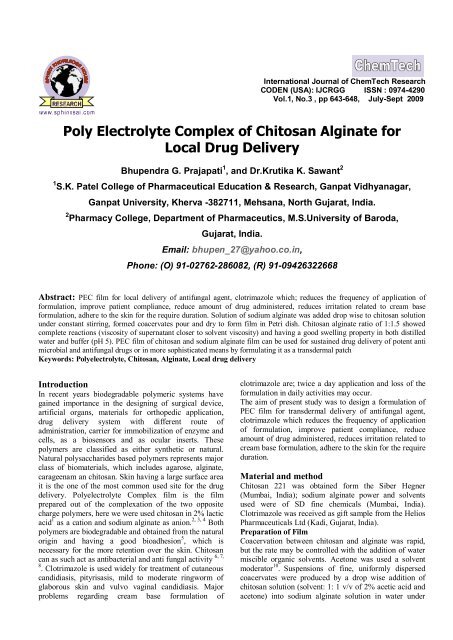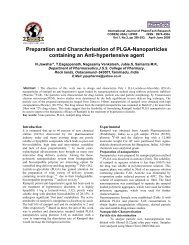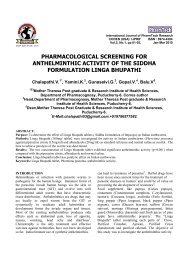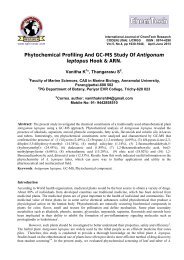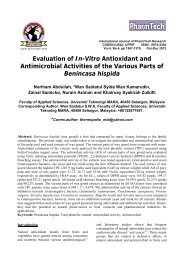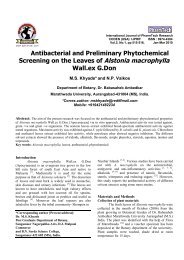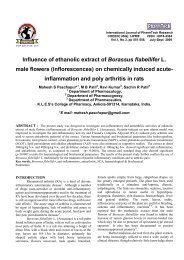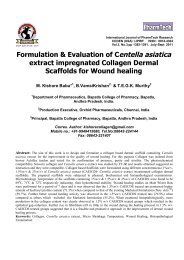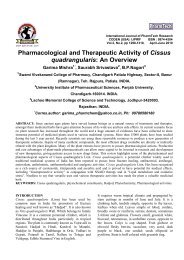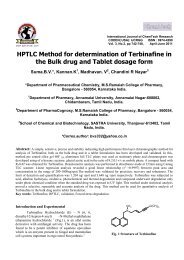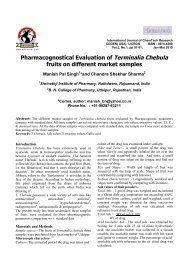Poly Electrolyte Complex of Chitosan Alginate for Local Drug Delivery
Poly Electrolyte Complex of Chitosan Alginate for Local Drug Delivery
Poly Electrolyte Complex of Chitosan Alginate for Local Drug Delivery
Create successful ePaper yourself
Turn your PDF publications into a flip-book with our unique Google optimized e-Paper software.
International Journal <strong>of</strong> ChemTech Research<br />
CODEN (USA): IJCRGG ISSN : 0974-4290<br />
Vol.1, No.3 , pp 643-648, July-Sept 2009<br />
<strong>Poly</strong> <strong>Electrolyte</strong> <strong>Complex</strong> <strong>of</strong> <strong>Chitosan</strong> <strong>Alginate</strong> <strong>for</strong><br />
<strong>Local</strong> <strong>Drug</strong> <strong>Delivery</strong><br />
Bhupendra G. Prajapati 1 , and Dr.Krutika K. Sawant 2<br />
1 S.K. Patel College <strong>of</strong> Pharmaceutical Education & Research, Ganpat Vidhyanagar,<br />
Ganpat University, Kherva -382711, Mehsana, North Gujarat, India.<br />
2 Pharmacy College, Department <strong>of</strong> Pharmaceutics, M.S.University <strong>of</strong> Baroda,<br />
Gujarat, India.<br />
Email: bhupen_27@yahoo.co.in,<br />
Phone: (O) 91-02762-286082, (R) 91-09426322668<br />
Abstract: PEC film <strong>for</strong> local delivery <strong>of</strong> antifungal agent, clotrimazole which; reduces the frequency <strong>of</strong> application <strong>of</strong><br />
<strong>for</strong>mulation, improve patient compliance, reduce amount <strong>of</strong> drug administered, reduces irritation related to cream base<br />
<strong>for</strong>mulation, adhere to the skin <strong>for</strong> the require duration. Solution <strong>of</strong> sodium alginate was added drop wise to chitosan solution<br />
under constant stirring, <strong>for</strong>med coacervates pour and dry to <strong>for</strong>m film in Petri dish. <strong>Chitosan</strong> alginate ratio <strong>of</strong> 1:1.5 showed<br />
complete reactions (viscosity <strong>of</strong> supernatant closer to solvent viscosity) and having a good swelling property in both distilled<br />
water and buffer (pH 5). PEC film <strong>of</strong> chitosan and sodium alginate film can be used <strong>for</strong> sustained drug delivery <strong>of</strong> potent anti<br />
microbial and antifungal drugs or in more sophisticated means by <strong>for</strong>mulating it as a transdermal patch<br />
Keywords: <strong>Poly</strong>electrolyte, <strong>Chitosan</strong>, <strong>Alginate</strong>, <strong>Local</strong> drug delivery<br />
Introduction<br />
In recent years biodegradable polymeric systems have<br />
gained importance in the designing <strong>of</strong> surgical device,<br />
artificial organs, materials <strong>for</strong> orthopedic application,<br />
drug delivery system with different route <strong>of</strong><br />
administration, carrier <strong>for</strong> immobilization <strong>of</strong> enzyme and<br />
cells, as a biosensors and as ocular inserts. These<br />
polymers are classified as either synthetic or natural.<br />
Natural polysaccharides based polymers represents major<br />
class <strong>of</strong> biomaterials, which includes agarose, alginate,<br />
carageenam an chitosan. Skin having a large surface area<br />
it is the one <strong>of</strong> the most common used site <strong>for</strong> the drug<br />
delivery. <strong>Poly</strong>electrolyte <strong>Complex</strong> film is the film<br />
prepared out <strong>of</strong> the complexation <strong>of</strong> the two opposite<br />
charge polymers, here we were used chitosan in 2% lactic<br />
acid 1 as a cation and sodium alginate as anion. 2, 3, 4 Both<br />
polymers are biodegradable and obtained from the natural<br />
origin and having a good bioadhesion 5 , which is<br />
necessary <strong>for</strong> the more retention over the skin. <strong>Chitosan</strong><br />
can as such act as antibacterial and anti fungal activity<br />
8 . Clotrimazole is used widely <strong>for</strong> treatment <strong>of</strong> cutaneous<br />
candidiasis, pityrisasis, mild to moderate ringworm <strong>of</strong><br />
glaborous skin and vulvo vaginal candidiasis. Major<br />
problems regarding cream base <strong>for</strong>mulation <strong>of</strong><br />
6, 7,<br />
clotrimazole are; twice a day application and loss <strong>of</strong> the<br />
<strong>for</strong>mulation in daily activities may occur.<br />
The aim <strong>of</strong> present study was to design a <strong>for</strong>mulation <strong>of</strong><br />
PEC film <strong>for</strong> transdermal delivery <strong>of</strong> antifungal agent,<br />
clotrimazole which reduces the frequency <strong>of</strong> application<br />
<strong>of</strong> <strong>for</strong>mulation, improve patient compliance, reduce<br />
amount <strong>of</strong> drug administered, reduces irritation related to<br />
cream base <strong>for</strong>mulation, adhere to the skin <strong>for</strong> the require<br />
duration.<br />
Material and method<br />
<strong>Chitosan</strong> 221 was obtained <strong>for</strong>m the Siber Hegner<br />
(Mumbai, India); sodium alginate power and solvents<br />
used were <strong>of</strong> SD fine chemicals (Mumbai, India).<br />
Clotrimazole was received as gift sample from the Helios<br />
Pharmaceuticals Ltd (Kadi, Gujarat, India).<br />
Preparation <strong>of</strong> Film<br />
Coacervation between chitosan and alginate was rapid,<br />
but the rate may be controlled with the addition <strong>of</strong> water<br />
miscible organic solvents. Acetone was used a solvent<br />
moderator 10 . Suspensions <strong>of</strong> fine, uni<strong>for</strong>mly dispersed<br />
coacervates were produced by a drop wise addition <strong>of</strong><br />
chitosan solution (solvent: 1: 1 v/v <strong>of</strong> 2% acetic acid and<br />
acetone) into sodium alginate solution in water under
Bhupendra G. Prajapati et al /Int.J. ChemTech Res.2009,1(3) 644<br />
rapid agitation. After this, the viscous polymeric<br />
coacervate was obtained to which propylene glycol was<br />
added as plasticizer. Accurately weighed quantity <strong>of</strong> drug,<br />
clotrimazole was added and stirred gently <strong>for</strong> 2 min to get<br />
uni<strong>for</strong>m dispersion. The resultant coacervate gel was kept<br />
a side <strong>for</strong> sometime to remove air bubble and then it was<br />
casted into plastic petri dish <strong>of</strong> 5 cm diameter. Petri dish<br />
was kept into vacuum oven at 60 0 C <strong>for</strong> 24 hours drying.<br />
The completely dry film was stored in airtight container<br />
at room temperature.<br />
Formulation Conditions<br />
To get fine and uni<strong>for</strong>m coacervate <strong>of</strong> chitosan-alginate,<br />
various process parameters like type <strong>of</strong> water miscible<br />
solvent addition, stirrer, speed <strong>of</strong> stirrer, time <strong>of</strong> reaction,<br />
temperature <strong>of</strong> drying, drying time, concentration <strong>of</strong><br />
plasticizer, chitosan-alginate ration and drug to polymer<br />
ration were optimized based on quality <strong>of</strong> the complex<br />
coacervates obtained.<br />
Various batches <strong>of</strong> complex coacervate were prepared by<br />
varying the parameters under study, like <strong>for</strong> selection <strong>of</strong><br />
stirrer coacervates were prepared using both magnetic<br />
and three-blade stirrer. For selection <strong>of</strong> speed <strong>of</strong> batches<br />
were prepared at high (4000), medium (2000) and low<br />
(1000) speeds. Three batches were reacted <strong>for</strong> different<br />
time <strong>of</strong> 10, 20 and 30 min. Drying time and temperature<br />
was optimized by taking drying three batches at room<br />
temperature, at 60 0 C and at 70 0 C respectively. Different<br />
concentration <strong>of</strong> propylene glycol as plasticizer was<br />
studied i.e. 0.3%, 0.5% and 0.7%. Finally batches <strong>of</strong><br />
films were prepared with different ratio <strong>of</strong> chitosan to<br />
alginate i.e. 1:1, 1:1.5, 1:2 and 2:1. Viscosity <strong>of</strong> the<br />
supernatant obtained after complexatoin <strong>of</strong> two polymers<br />
in different ratio was measured. Films prepared <strong>of</strong><br />
different ratio <strong>of</strong> polymer were studied <strong>for</strong> swelling<br />
behaviors. <strong>Poly</strong>mer-To-<strong>Poly</strong>mer Ratio<br />
This work was carried out with four different ratio <strong>of</strong><br />
chitosan: alginate (1:1,1:1.5,1:2 and 2:1). The prepared<br />
polyelectrolyte films were evaluated <strong>for</strong> supernatant<br />
viscosity data and swelling index.<br />
<strong>Poly</strong>mer To <strong>Drug</strong> Ratio<br />
The polyelectrolyte film were prepared using four<br />
different ratio <strong>of</strong> polymer to clotrimazole powder (1.:<br />
2,1:2, 1:3 and 1:4) and evaluated <strong>for</strong> swelling index and<br />
invitro drug diffusion.<br />
Evaluation <strong>of</strong> Film<br />
Swelling Index 11<br />
Weighed pieces 1x1 cm 2 <strong>of</strong> film were immersed in<br />
distilled water; at 0.5, 1, 2, 4, 8 and 24 hours. Soaked<br />
films were removed from the medium at predetermined<br />
time, blotted to remove excess liquid and weighed<br />
immediately. The swelling index was calculated from the<br />
weight increase, as follows:<br />
Where W1and W2 are the weight <strong>of</strong> the film be<strong>for</strong>e and<br />
after immersion in the medium, respectively.<br />
Tensile Strength 10<br />
The mechanical properties <strong>of</strong> chitosan alginate films were<br />
evaluated using a texture analyzer (Instron Universal<br />
Model) equipped with a 500 gm load cell. Film strip in<br />
10 mm X 10 mm <strong>of</strong> dimension and free from air bubbles<br />
or physical imperfections, was held between two clamps<br />
positioned at a distance <strong>of</strong> 1 cm. During measurement,<br />
the film was pulled by top clamp at a rate <strong>of</strong><br />
10mm/minutes. The <strong>for</strong>ce and elongation were measured<br />
when the films broke. Measurements were run four times<br />
<strong>for</strong> each film. The tensile strength and elongation at break<br />
were calculated as below:<br />
Tensile strength (kg/mm 2 ) = Breaking <strong>for</strong>ce (kg)/Crosssectional<br />
area <strong>of</strong> sample (mm 2 )<br />
Elongation at break (%) = Increase in length at breaking<br />
point (mm)/Original length (mm) x100%<br />
Content Uni<strong>for</strong>mity<br />
To ensure uni<strong>for</strong>m distribution <strong>of</strong> clotrimazole in film, a<br />
content uni<strong>for</strong>mity test was per<strong>for</strong>med. Sample represent<br />
different regions within film <strong>of</strong> 1X1 cm 2 section <strong>of</strong> the<br />
optimized chitosan alginate film were cut from four<br />
different locations and were crushed and dipped to<br />
solvent system <strong>of</strong> 9:1 <strong>of</strong> acetate buffer and PEG 400 <strong>for</strong><br />
24 hours at room temperature. Content was filter out and<br />
filtrate was analyzed <strong>for</strong> drug content by UV<br />
spectrophotometrically.<br />
Content Uni<strong>for</strong>mity=<br />
= Actual amount <strong>of</strong> drug in film X 100<br />
Theoretical amount <strong>of</strong> drug<br />
present in film<br />
In Vitro <strong>Drug</strong> Diffusion 11<br />
In vitro drug diffusion, from chitosan alginate film was<br />
studied using modified franz diffusion cell with 2.52 cm2<br />
diffusion area and 20ml receptor volume. 1:9 ratio <strong>of</strong><br />
PEG 400 to acetate buffer (pH 5) was used to maintain<br />
sink conditions in the receptor compartment. Human<br />
cadaver skin was used as diffusion membrane. At<br />
different time interval aliquots were withdrawn and<br />
replaced with fresh buffer. Absorbance was measured.<br />
Comparative diffusion studies<br />
For comparative diffusion studies diffusion <strong>of</strong> final film<br />
containing drug to polymer ratio <strong>of</strong> 1:4 and cream base<br />
marketed <strong>for</strong>mulation was carried out using Franz<br />
diffusion cell. Accurately weighed quantity <strong>of</strong> cream that<br />
was equivalent to drug contained in diffusion area <strong>of</strong> film<br />
was taken <strong>for</strong> study.<br />
For this rat skin was used as membrane. Male S D Rat<br />
was anesthetized and an area <strong>of</strong> 3 cm2 was clean shaved<br />
on dorsal side. Skin was carefully cut and washed with<br />
phosphate buffer pH-7.4 be<strong>for</strong>e use.<br />
Result and discussion<br />
Preparation <strong>of</strong> Film<br />
For preparation <strong>of</strong> good film, it is desirable that the<br />
polyelectrolyte complex coacervate suspension, which is
Bhupendra G. Prajapati et al /Int.J. ChemTech Res.2009,1(3) 645<br />
cast to <strong>for</strong>m the film, must be fine and uni<strong>for</strong>m. The<br />
reaction rate <strong>of</strong> chitosan to alginate was very high, which<br />
can be controlled by addition water miscible solvent like<br />
acetone and methanol. Mixture <strong>of</strong> methanol and acetone<br />
was tried in different ratio with 2% lactic acid in<br />
preparation <strong>of</strong> chitosan solution respectively. i.e. 30:50,<br />
50:50 and 30:70. Out <strong>of</strong> which acetone: lactic acid (2%)<br />
in 50:50 showed good and fine coacervate. Further more<br />
to obtained high quality <strong>of</strong> complex coavervate slow drop<br />
wise addition <strong>of</strong> chitosan solution at high-speed threeblade<br />
stirrer (4000 rpm) <strong>for</strong> 30 minutes at room<br />
temperature was carried out. Propylene glycol in 0.5%<br />
was used to obtained flexible film and <strong>for</strong> good peeling<br />
<strong>of</strong> film.<br />
<strong>Poly</strong>mer-To-<strong>Poly</strong>mer Ratio<br />
Optimization <strong>of</strong> chitosan alginate ratio <strong>for</strong> preparation <strong>of</strong><br />
complex coacervates was carried out based on the<br />
swelling ratio <strong>of</strong> prepared film in distilled water and<br />
acetate buffer solution, as the swelling state <strong>of</strong> the<br />
polymer was reported to be crucial <strong>for</strong> its release<br />
behavior and based on viscosity data <strong>of</strong> supernatant <strong>of</strong><br />
complex coacervate to show complete reaction between<br />
chitosan and alginate.<br />
The viscosity <strong>of</strong> supernatant shown in table 1 shows that<br />
coacervates <strong>of</strong> 1:1.5 ratio <strong>of</strong> chitosan to alginate viscosity<br />
was nearly same <strong>of</strong> the solvent system used which<br />
indicates the complete reaction <strong>of</strong> the two polymers and<br />
thus the ratio was optimizes.<br />
The swelling data obtained <strong>for</strong> different chitosan-alginate<br />
ratio in distilled water and acetate buffer pH 5 to PEG<br />
400 (9:1) are shown in Fig 1, 2 respectively. Comparative<br />
swelling data (fig 1, 2) shows that <strong>for</strong> all the polymer<br />
ratios swelling continuously increased up to 8 hours and<br />
then slowly reached equilibrium level. Maximum<br />
swelling was observed in 1:2 <strong>of</strong> CH: SA ratio, while least<br />
swelling in 2:1 <strong>of</strong> CH: SA ratio. This indicates that<br />
increase in alginate concentration causes higher swelling<br />
and vice versa. From fig 1, 2 it can be concluded that<br />
swelling was more in case <strong>of</strong> distilled water as compared<br />
to acetate buffer. That indicates swelling was lower in<br />
acidic pH compared to neutral.<br />
Tensile strength and % elongation data shown in table 2,<br />
which indicates that as the chitosan concentration<br />
increases in film, Tensile strength and % elongation<br />
increases, while increase in sodium alginate decreases Ts<br />
and % elongation.<br />
From complied data <strong>of</strong> table 1 and 2 it was decided to<br />
use polymer drug ratio <strong>of</strong> 1:1.5 which shows complete<br />
reaction <strong>of</strong> two polymer, with good swelling and<br />
mechanical property <strong>for</strong> further work.<br />
<strong>Poly</strong>mer To <strong>Drug</strong> Ratio<br />
The drug to polymer ratio was optimized on the basis <strong>of</strong><br />
swelling as well as from the drug diffusion through the<br />
film. Diffused drug analyzed by UV Spectrophotometry<br />
at 228.6 nm.<br />
Table 3 showed the summarized data <strong>of</strong> the drug loaded<br />
PEC film, which shows that swelling capacity <strong>for</strong> various<br />
drug to polymer ratio increases gradually up to 8 hours,<br />
after which it attains saturation. As drug concentration<br />
increases, the swelling was decreased, which indicates<br />
that the drug has a reducing effect on swelling properties<br />
<strong>of</strong> film. Maximum swelling was observed <strong>of</strong> 3.346 ±<br />
0.107 in 1:5 ratio and minimum swelling <strong>of</strong> 2.575 ±<br />
0.304 <strong>for</strong> 1:2 drugs to polymer ratio.<br />
Maximum drug release (table 3 & fig 3) in 24 hours was<br />
observed (66.58±0.46) in 1:2 drug: polymer ratio, while<br />
minimum (28.36±0.21) in 1:5 drug: polymer ratio. Thus<br />
higher the concentration <strong>of</strong> polymer, drug release<br />
decreased. But 1:4 ratio was selected as further more<br />
increase in concentration <strong>of</strong> polymer part not showed<br />
much difference in release behavior and it shows good<br />
mechanical strength compared to 1:5 <strong>of</strong> drug to polymer<br />
ratio.<br />
Evaluation <strong>of</strong> Film<br />
Data <strong>of</strong> Table 3 shows that swelling index <strong>of</strong> film was<br />
found to be 3.216 ± 0.125, which shows that the film can<br />
be utilize <strong>for</strong> the purpose <strong>of</strong> controlled drug release. The<br />
data <strong>of</strong> tensile strength and % elongation (table 3) shows<br />
decrease in mechanical strength <strong>of</strong> film, as the drug part<br />
was increase in drug to polymer ratio i.e. drug indirectly<br />
affects the mechanical properties <strong>of</strong> film. Content<br />
uni<strong>for</strong>mity <strong>of</strong> film was found to be 98.88 ± 2.38 % w/w,<br />
which confirms uni<strong>for</strong>m and reproducible distribution <strong>of</strong><br />
drug within entire film.<br />
In vitro drug diffusion<br />
Comparative diffusion studies from semi permeable<br />
membrane <strong>for</strong> different drug: polymer ratio batches (Fig.<br />
3) showed that up to 2 hours there was gradual increase<br />
in the drug diffusion probably due to film swelling. After<br />
2 hours drug release slowed down due to diffusioncontrolled<br />
mechanism. That drug release from the film<br />
was initially affected by the swelling <strong>of</strong> the film and<br />
hence it can be considered the rate-limiting step, affecting<br />
the drug release <strong>for</strong>m the film.<br />
Comparative <strong>of</strong> <strong>for</strong>mulation by vitro drug diffusion<br />
Diffusion data <strong>of</strong> 24 hrs <strong>of</strong> clotrimazole shows that film<br />
<strong>for</strong>mulation gives most controlled and sustained drug<br />
release compared to other <strong>for</strong>mulations. Cream<br />
<strong>for</strong>mulation gives fastest drug release. Sustained drug<br />
release from film <strong>for</strong>mulation is due to drug entrapment<br />
into network like structure <strong>of</strong> complex coacervates.<br />
Conclusion<br />
<strong>Poly</strong>electrolyte complex film <strong>of</strong> chitosan and sodium<br />
alginate film can be used <strong>for</strong> sustained drug delivery <strong>of</strong><br />
potent anti microbial and antifungal drugs by transdermal<br />
drug delivery. The combination <strong>of</strong> appropriate drug and<br />
chitosan can help to recover topical infections. This<br />
polyelectrolyte complex film can be modified to use in<br />
more sophisticated means by <strong>for</strong>mulating it as a<br />
transdermal patch as it uses the bioadhesive and<br />
biodegradable non toxic polymers.
Bhupendra G. Prajapati et al /Int.J. ChemTech Res.2009,1(3) 646<br />
Acknowledgement<br />
We acknowledge SiberHegner (Mumbai, India) and<br />
Halios Phamaceutical (kadi, Gujarat, India) <strong>for</strong> provide<br />
chitosan and drug <strong>for</strong> above work.<br />
Table 1: Supernatant viscosity data<br />
Ratio <strong>of</strong> chitosan: alginate Viscosity <strong>of</strong> supernatant (cps)<br />
Solvent 0.9935<br />
1:1 1.2119<br />
1:2 1.2710<br />
1:1.5 0.9992<br />
Table 2: Summarized data <strong>of</strong> optimization <strong>of</strong> chitosan to alginate ratio<br />
Ratio<br />
CH*: SA*<br />
Thickness<br />
mm ± SD<br />
Tensile strength<br />
Kg/mm 2 ±SD<br />
We special acknowledge department <strong>of</strong> pharmaceutics, <strong>of</strong><br />
pharmacy college, M.S.Uni. <strong>of</strong> Baroda, Gujarat, India to<br />
provide the facility to carry out work.<br />
%Elongation<br />
±SD<br />
Swelling ratio<br />
±SD<br />
1:1 0.11±0.01 0.195±0.029 68±2 1.985±0.349<br />
1:1.5 0.10±0.02 0.182±0.017 72±3 3.925±0.465<br />
1:2 0.11±0.01 0.162±0.022 78±2 3.619±0.398<br />
2:1 0.11±0.02 0.250±0.036 89±4 1.268±0.285<br />
* CH-<strong>Chitosan</strong>, * SA-Sodium <strong>Alginate</strong><br />
Table 3: Summarized data <strong>for</strong> drug loaded film<br />
<strong>Drug</strong><br />
:polymer<br />
Ratio<br />
Thickness<br />
mm ± SD<br />
1:2 0.11<br />
±0.01<br />
1:3 0.11<br />
±0.02<br />
1:4 0.11<br />
±0.02<br />
1:5 0.12<br />
±0.01<br />
Tensile<br />
strength<br />
Kg/mm2 ±SD<br />
0.186<br />
±0.19<br />
0.168<br />
±0.05<br />
0.154<br />
±0.12<br />
0.134<br />
±0.036<br />
%<br />
Elongation<br />
±SD<br />
Swelling ratio<br />
±SD<br />
76±1 2.575<br />
±0.304<br />
70±2 3.022<br />
± 0.151<br />
66±3 3.216<br />
± 0.125<br />
53±4 3.346<br />
± 0.107<br />
% <strong>Drug</strong><br />
Diffuse<br />
±SD<br />
66.58<br />
±0.46<br />
42.31<br />
±0.82<br />
30.19<br />
±0.36<br />
28.36<br />
±0.21
Bhupendra G. Prajapati et al /Int.J. ChemTech Res.2009,1(3) 647<br />
Figure 1 Swelling ratio <strong>of</strong> film in distilled water<br />
Swellling Ratio<br />
4<br />
3.5<br />
3<br />
2.5<br />
2<br />
1.5<br />
1<br />
0.5<br />
0<br />
0 5 10 15 20 25 30<br />
Time in Hrs<br />
1:1 1:2 1:1.5 2:1<br />
Figure 2 Swelling capacity <strong>of</strong> film in 9:1 <strong>of</strong> acetate buffer pH 5 and PEG 400<br />
Swelling ratio<br />
3.5<br />
3<br />
2.5<br />
2<br />
1.5<br />
1<br />
0.5<br />
0<br />
0 5 10 15 20 25 30<br />
Time in hrs<br />
1:2 1:3 1:4 1:5<br />
Figure 3: In vitro drug diffusion across semi permeable membrane<br />
% <strong>Drug</strong> Diffused<br />
80<br />
70<br />
60<br />
50<br />
40<br />
30<br />
20<br />
10<br />
0<br />
0 5 10 15 20 25 30<br />
Time in Hrs<br />
1:2 1:3 1:4 1:5
Bhupendra G. Prajapati et al /Int.J. ChemTech Res.2009,1(3) 648<br />
Figure 4: Comparison <strong>of</strong> In vitro drug diffusion through rat skin<br />
% <strong>Drug</strong> Diffused<br />
80<br />
70<br />
60<br />
50<br />
40<br />
30<br />
20<br />
10<br />
0<br />
0 5 10 15 20 25 30<br />
Time in Hours<br />
chitosan alginate film cream<br />
References<br />
1. Peh K, Khan T, Ch'ng H. “Mechanical,<br />
bioadhesive strength and biological evaluations<br />
<strong>of</strong><br />
chitosan films <strong>for</strong> wound dressing”. J Pharm<br />
Pharm Sci. 2000; 3(3): 303-311.<br />
1. Yan XL, Khor E, Lim LY, “<strong>Chitosan</strong>-<strong>Alginate</strong><br />
Films Prepared with <strong>Chitosan</strong>s <strong>of</strong> Different<br />
Molecular Weights”. J Biomed Mater Res. 2001;<br />
58(4): 358-65.<br />
2. Kim HJ, Lee HC, Oh JS, Shin BA, Oh CS, Park<br />
RD, Yang KS, Cho CS., “<strong>Poly</strong>electrolyte<br />
complex composed <strong>of</strong> chitosan and sodium<br />
alginate <strong>for</strong> wound dressing application” J<br />
Biomater Sci <strong>Poly</strong>m Ed. 1999; 10 (5): 543-56.<br />
3. Wang L, Khor E, Wee A, Lim LY. “<strong>Chitosan</strong>-<br />
<strong>Alginate</strong> PEC Membrane as a Wound Dressing:<br />
Assessment <strong>of</strong> Incisional Wound Healing”. J<br />
Biomed Mater Res. 2002; 63 (5): 610-618.<br />
4. Miyazaki S, Nakayama A, Oda M, Takada M,<br />
Attwood D, “<strong>Chitosan</strong> and sodium alginate<br />
based bioadhe- sive tablets <strong>for</strong> intraoral drug<br />
delivery”. Biol Pharm Bull. 1994; 17 (5): 745-<br />
747.<br />
5. Nishimura K, Nishimura S, Nishi N, Saiki I,<br />
Tokura S, Azuma I. “Immunological activity <strong>of</strong><br />
*****<br />
chitin and its derivatives”. Vaccine 1984; 2: 93-<br />
99.<br />
6. Choi BK, Kim KY, Yoo YJ, Oh SJ, Choi JH,<br />
Kim CY. “In vitro antimicrobial activity <strong>of</strong> a<br />
chitooligosaccharide mixture against<br />
Actinobacillus“ Int J Antimicrob Agents 2001;<br />
18: 553-557.<br />
7. Muzzarelli RAA. “Human enzymatic activities<br />
related to the therapeutic administration <strong>of</strong> chitin<br />
derivatives “. Cell Mol Life Sci 1997; 53: 131-<br />
140.<br />
8. Yan X, Khor E, Lim LY. “PEC films prepared<br />
from chitosanalginate coacervates”. Chem<br />
Pharm Bull (Tokyo) 2000; 48 (7): 941-946.<br />
9. Kok Khiang Peh and Choy Fun Wong,<br />
“<strong>Poly</strong>meric Films As Vehicle For Buccal<br />
<strong>Delivery</strong>: Swelling, Mechanical, and<br />
Bioadhesive Properties”. J Pharm Pharmaceut<br />
Sci. 1999; 2 (2): 53-61<br />
10. Babar A, Ray SD, Patel NK, Plakogiannis FM,<br />
Gogineni P.” In vitro release and diffusion<br />
studies <strong>of</strong> promethazine hydrochloride from<br />
polymeric dermatological bases using cellulose<br />
membrane and hairless mouse skin”. <strong>Drug</strong> Dev<br />
Ind Pharm. 1999;25 (2):235-40.


